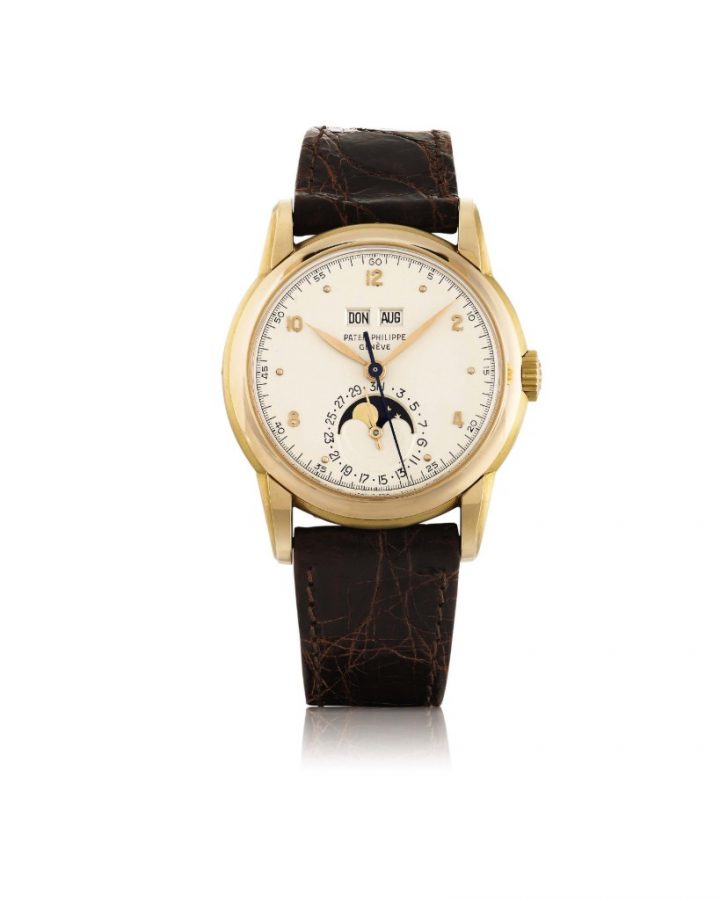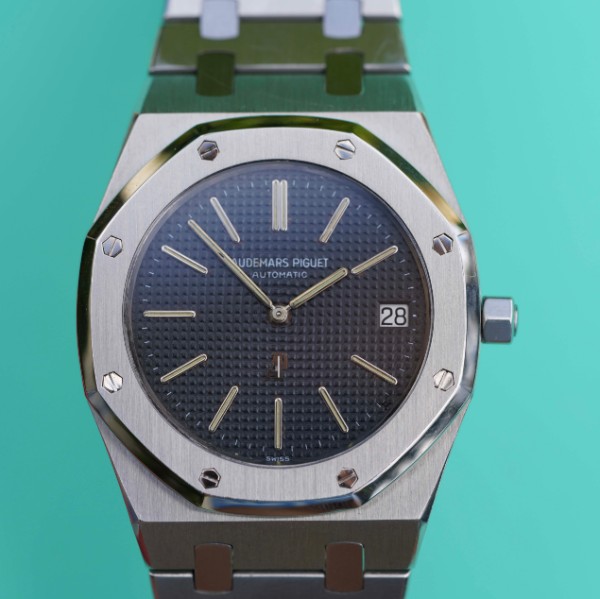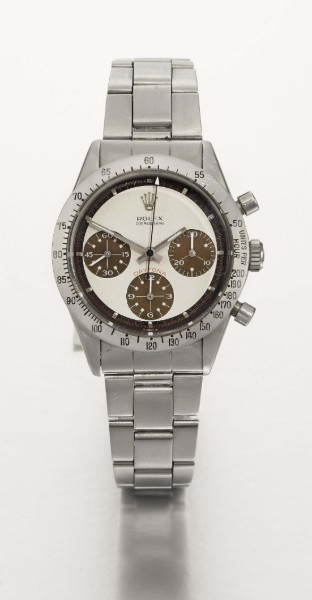When it comes to high-end timepieces, less can sometimes be more. While highly complicated and ornate watches seem to dominate the market, classic examples with an understated elegance can turn heads just as effectively. With that in mind, we solicited the insight of a handful of watch specialists to produce a short list of vintage timepieces that are perpetually in demand.
Rolex GMT-Master

vInitially designed for Pan Am pilots during the 1950s, Rolex’s GMT-Master (Reference 1675) represented an out-of-character approach for the brand, which up until that point had generally focused on austere designs set with white or black dials and steel or black bezels. This watch, by contrast, featured a red and blue bezel—now affectionately known as the “Pepsi bezel”—which allowed pilots to differentiate day from night in the watch’s second time zone, typically set to Greenwich Mean Time (GMT), by rotating the bezel.
“That splash of color in the bezel was something new and exciting for the company,” says Eric Wind, a former senior specialist at Christie’s, who now owns a high-end watch gallery, Wind Vintage, in West Palm Beach, Fla. “The usefulness of the GMT complication makes the GMT-Master model one of the most desirable and hottest watches today.”
“The GMT is as popular now as when it was first introduced,” adds Sam Hines, worldwide head of watches at Sotheby’s, who saw a 1963 “Cornino” reference 1675 example sell for 625,000 Hong Kong dollars (about $80,000) during a Sotheby’s auction in Hong Kong in October 2019. “It is the ultimate sports watch.”
Patek Philippe Perpetual Calendar

When it was introduced in 1951—and throughout its 12-year production run—Patek Philippe’s reference 2497 was the horological house’s first serially produced perpetual calendar wristwatch with center seconds. In fact, it was Patek Philippe’s only model with such a distinction until the brand introduced the reference 5050 in 1993. Wind says this classic Patek timepiece is “one of the quintessential, pure perpetual calendar watches that remains suited to today’s tests. It’s a wonderful example of Patek Philippe’s style at a time when watches were becoming more water-resistant and people wanted slightly larger and more aggressive watches.”
According to Max Traber, a watch specialist at Bonhams, this particular model perfectly illustrates the quality of Patek Philippe’s engineering and construction. “They are both mechanical masterpieces and magnificent-looking watches,” he says of these early perpetual calendars.
In May 2019, Sotheby’s set a world-record price for an example in pink gold. The watch sold for 980,000 Swiss francs (about $1 million).
Audemars Piguet Royal Oak “Series-A”

The night before the 1971 Basel watch show, Georges Golay, managing director of Audemars Piguet, approached designer Gerald Genta and issued a challenge. Golay wanted a watch that could disrupt the market and, in turn, redefine his brand. Overnight, Genta penned a design that took inspiration from steel diving helmets, featured a raised octagonal bezel with hexagonal screws, and included an integrated bracelet. Due to an initial lukewarm reception in 1972, only 2,000 “Series-A” Royal Oaks were produced, which makes them the most desirable of all model variants.
“This model has been the inspiration for some of the most cutting-edge, limited-edition wristwatches of the last 10 years,” says Hines, who saw a 1972 example sell for 62,500 Swiss francs (about $64,000) during a Sotheby’s Geneva auction in November 2019.
“Collecting one of these means owning a part of horological history,” adds Traber. “This watch single-handedly changed the luxury watch market.”
Patek Philippe Nautilus

A few years after Audemars Piguet debuted its Royal Oak, Patek Philippe tapped Genta to design something equally sleek for them. The Swiss designer found inspiration from portholes on various ships that had windows hermetically sealed through a system of tension bolts against the glass. When it was unveiled in 1976, the Patek Philippe Nautilus (reference 3700) was the most expensive steel sports watch on the market.
“Patek Philippe has always been known for its dress watches, and the Nautilus is a radical departure from the brand’s other designs,” says Traber. “Now, nearly 45 years later, this watch is often the first one that comes to peoples’ minds when they think of Patek Philippe.”
The watch’s design, similar to the Royal Oak, also makes it a relevant fashion accessory by today’s standards. “The integrated bracelet has made it more suitable to the athleisure and casual-dressing trend of today than a gold watch on a shiny alligator strap,” Wind says.
In December 2019, Bonhams sold an early example, circa 1979, for $88,928 in London.
Cartier Crash

Some believe Cartier based its women’s watch, The Crash, on Salvador Dali’s familiar painting The Persistence of Memory. Others suggest that a damaged timepiece pulled from the wreckage of a car accident provided the requisite inspiration. Either way, this watch was an instant hit when it was unveiled in 1967.
“The Crash was so groundbreaking that its case design is still as relevant today as it was first seen in the late ’60s,” says Hines. “It represents Cartier’s house style—not in its form, but in the brand’s philosophy to always push the boundaries in terms of style.”
Traber concurs. “This watch was a departure from the classic designs of the firm, and yet its look is inextricably Cartier,” he says. “It is both avant-garde and representative of the ‘swinging ’60s,’ all without sacrificing Cartier’s aesthetic.”
Early examples are most collectible, but younger reissued models are also in demand. As proof, Sotheby’s sold one, circa 1990, for HK$525,000 (about $67,000) during a Hong Kong auction in October 2019. Similarly, Bonhams sold a 1990s reissue in June 2018 for $42,213.
Rolex “Paul Newman” Daytona

When Rolex became the official timekeeper at Daytona International Speedway in 1962, the brand created the Cosmograph (Reference 6239), which was unveiled in 1963 and quickly was given the nickname “Daytona.” From the late 1960s through the mid-’70s, the watch house introduced to the Daytona a series of exotic dials, which were thought to appeal to race car drivers who could more easily read the times on the subdials. Initially, however, these dials failed to catch on with consumers. As Wind acknowledges, they were “an outrageous departure from the more common austere look of Rolex tool watches from that period of time.”
However, in the 1980s, when old images emerged of actor Paul Newman wearing one a decade earlier, things changed. “Once Paul Newman was seen wearing one, the watch affectionately took on his name and the rest is history,” says Traber.
According to Hines, the Paul Newman Daytona is the most popular vintage watch on the market today. “It is not limited to one geographic location,” he explains. “It is as popular in Italy as it is in Indonesia.”
Sotheby’s sold a rare stainless-steel example, circa 1969, for $975,000 in 2018.











































